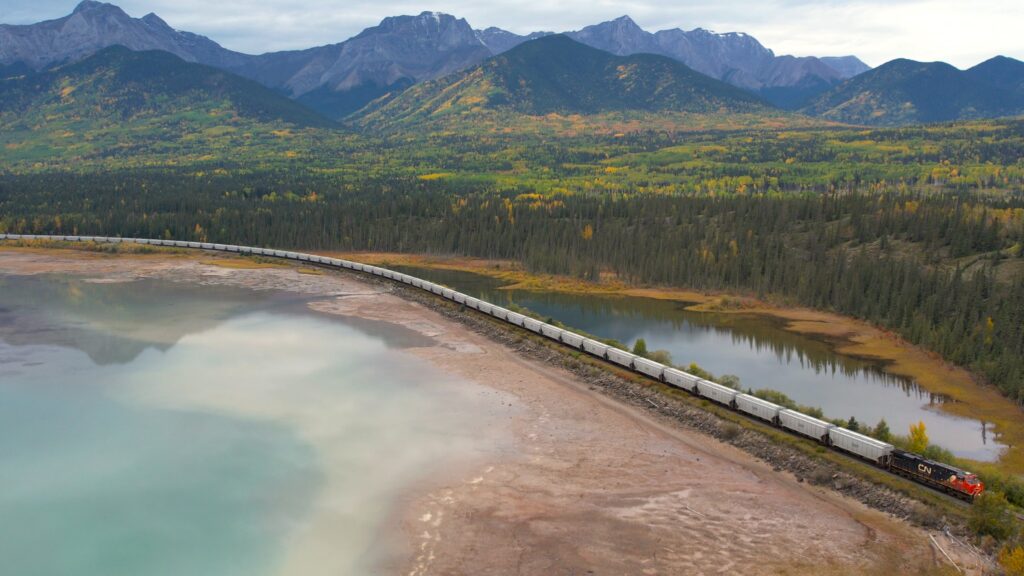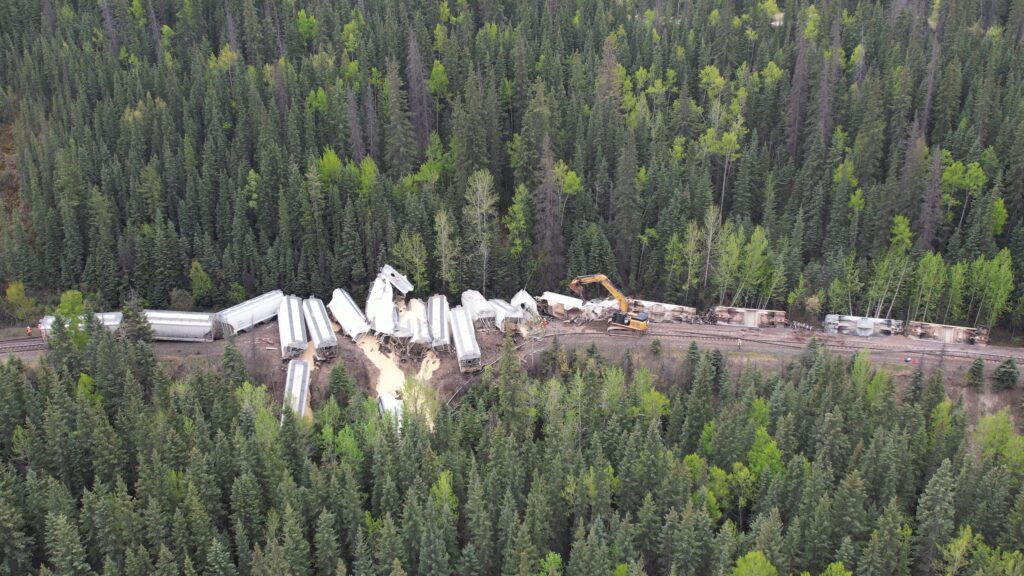Drone footage shows 23 “frac sand” cars being cleared from line after leaving the tracks June 1
The Transportation Safety Board of Canada (TSB) is gathering information about a June 1 train derailment outside of Jasper National Park to determine whether or not a full investigation is warranted.
In the early morning of June 1, 2024, a west-bound Canadian National (CN) freight train left the tracks in the Entrance, Alberta area. The train was hauling frac sand—material used in the hydraulic fracturing process to help access natural gas and petroleum deposits. TSB spokesperson Hugo Fontaine confirmed that 23 loaded covered hopper cars of sand derailed. No injuries occurred and no dangerous goods were involved, he added.
“We are still assessing the situation to determine whether to launch a full investigation,” Fontaine said.
Edmonton trainspotter, Tony Vandenberg, happened to be in the area on the day of the derailment. Vandenberg hosts a YouTube channel dedicated to “railfanning.” As part of his hobby, Vandenberg films and edits documentary-style videos about railroading and trains across Canada and the U.S.
“I tend to film in remote areas, away from traffic,” he told The Jasper Local. “I love to see the lay of the land.”
It was on an excursion to Swan Landing, near Brule, that Vandenberg got a bird’s eye view of the June 1 CN derailment. He said it was simply a matter of being in the right place at the right time.
“My goal was to film at Swan Landing. It’s a beautiful place to film,” he said.

Vandenberg said he initially got a clue something was wrong with the line west of Hinton when he noticed the Via Rail train sitting in the siding (a low-speed track section distinct from a running line or through-route). From his experience filming trains, Vandenberg knew the Via train typically rolled into the area at night.
“Once we knew the Via Number One had been sitting for four hours and that it was getting turned around to head back to Edmonton, we knew something major was up,” he said in his June 2 YouTube video.
Vandenberg’s second indication that something was awry was the chatter coming through on his radio scanner. He noticed CN dispatchers were calling for taxis to pick up the train crews, to bring them back to their home bases in Jasper and Edson.
“When we started hearing that we knew something’s not right,” he said.
Not long after, Vandenberg filmed a train approaching. He noticed it was shorter than normal, and also that the last car had a twisted coupler—or knuckle—where another car would typically be linked.
“As the rear car passes us, you can see that the knuckle and the draw bar are twisted,” he narrates in the video.
To gather more information, Vandenberg then broke out his drone-mounted video camera. Flying the machine high above the treetops, Vandenberg soon saw on his screen the hold up on the line.
A jumble of cars—their hoppers twisted and damaged, with sand spilling down the adjacent embankment—was being cleared from the tracks by a backhoe. The aerial footage shows CN crews milling about. It also shows the accident occurred not far from a bridge over the Athabasca River.

CN has said the cause of the derailment is still under investigation. A Jasper railroader whose identity The Jasper Local agreed to protect said the incident was the result of a broken track.
Vandenberg, who doesn’t speculate on the cause of the derailment in his video, said on a curved line such as where the derailment occurred, if a track does break, its tendency is to straighten out.
“But there could be many different reasons [for a derailment],” he noted.
The line was reopened as of Monday, June 3. A spokesperson for CN said on June 10 that the clean up has been completed.
TSB investigations aim to advance transportation safety, not assign fault or determine liability, Fontaine said.


